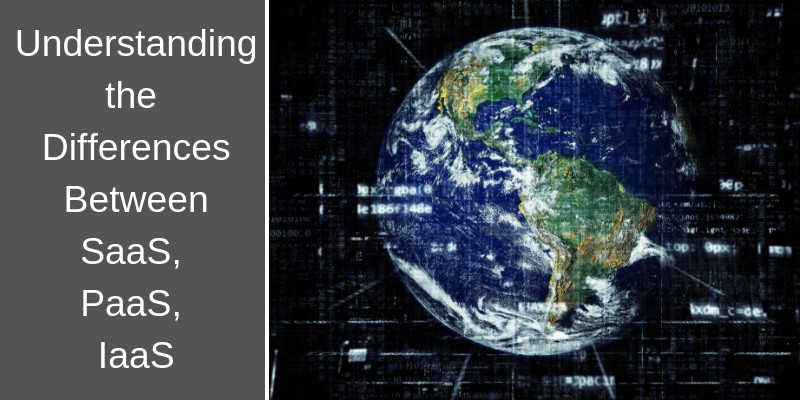Few industries in the world move on as fast as the tech industry. New technology can last as little as two years and be redundant the next. Industry-moving advancements like the cloud don’t come around very often, and when they do, they are here to stay.

Before adopting technology such as this, it’s crucial to be able to explain why the choice was made in choosing the kind of cloud service you made.
In particular, there are three kinds of cloud services your company should be making use of: Software as a Service (SaaS), Infrastructure as a Service (IaaS) and Platform as a Service (PaaS).
Each of these has key strengths and weaknesses as discussed below.
Infrastructure as a Service (IaaS)
IaaS can be thought of as the true replacement for on-premises server and network technology. It delivers highly-scalable computing resources, more of which can always be plugged in if need be.
In essence, IaaS is meant to deliver access to computational, networking, data storage and processing servers over the internet.
Rather than have a server delivered to your office building for company use, you get access to someone else’s server through an API, for example.
Depending on the kind of software, you might even be allowed full access – to SSH your way in and manage it yourself, as with a VPS. It replaces the hassle of maintaining your own server farm with renting out a distant cloud service.
Advantages
The main advantage of relying on an IaaS platform is that scaling is a lot easier than on-premises. If you are facing a sudden spike in the number of visitors, plugging in additional memory is as easy as visiting the host website and clicking a button.
On the other hand, if you’re like most businesses, you can expand the storage space, RAM and even database space as your business grows.
Additionally, the hassle of making sure your servers are always up and running is left to the IT staff of the provider, rather than have you do all the heavy lifting.
Servers need to be cooled, have their uptime maintained, electricity bills paid, software updated and so on. All of this is done by the vendor.
The best examples of Software as a Service are Digital Ocean, AWS, Microsoft Azure, Google Cloud Engine, Rackspace and Linode.
Software as a Service (SaaS)
SaaS is the most common type of application that’s delivered over the internet today. It refers to software that’s delivered ready for use, as opposed to traditional software that needs to be downloaded and installed. Normally, these solutions are just run directly from the web browser.
Worrying about what software the server is running, how smoothly it’s doing and making sure it’s always up isn’t your problem.
The company developers take care of that. You, as a business owner or a student entrepreneur, can simply focus on your other works like marketing the business, your full-time job or your college work.
Advantages
The main advantage to SaaS, arguably one of the best outcomes of cloud computing, is the elimination of the need to maintain the same software over multiple infrastructures.
Rather than downloading the same software on multiple computers, making sure the license keys are up-to-date and the software itself is updated, let someone else worry about it. Your job is simply to use it.
This is where most cloud-based software lies, as long as it provides some sort of utility. Examples include Dropbox, Gmail, Dribble, and Slack.
Platform as a Service (PaaS)
PaaS applications are usually also referred to as cloud platform services, can be thought of as a hybrid between SaaS and IaaS. They provide some aspects of working on the cloud but are instead used to create applications.
Unlike SaaS, which delivers to you a ready software for a specific use; or IaaS, which gives you the computing power to run all your tasks; PaaS indirectly grants you server space and a platform where you can create other applications.
You don’t need to worry about the networking bits, how much storage you’ve used, or managing the server you’re hosting on. PaaS just acts as a middle-man. It allows you to create software with proprietary components.
Advantages
PaaS applications take away the need for you to worry about managing a whole server by yourself, for the most part. You don’t need to worry about which webserver to use and how to attach a load-balancer. All that has been taken care of.
Most PaaS applications come with the necessary server applications already installed. Normally, you’d have to go about checking if all the dependencies your Jupyter Notebook needs are already installed, PaaS abstracts this away. The same goes for keeping server software up-to-date.
Examples include AWS, which offers some PaaS aspects, Heroku, and Google App Engine.
Which kind of software should you choose?
Each kind of software is best suited to a certain kind of use, for the most part. Knowledge of the difference between the three kinds of software comes most in handy at this point.
When to Use PaaS
If multiple developers are working on a single project and need to work together, a PaaS platform is probably what you need. For example, GitHub.
Developers that need to reduce the cost of running their own software can also greatly benefit from PaaS. Eg. Quick deployment via Netlify.
If you need to create a custom software without going through the trouble of getting your hands dirty, a PaaS solution likely exists somewhere. E.g. Wix and Squarespace.
When to Use SaaS
SaaS works best when you have needs that need quick fulfillment. For instance, an e-commerce platform that just lets you post things rather than build your own online shop – such as Amazon.
For apps that need both mobile and web access, SaaS is the only way to go. This is especially advantageous in the event they offer a PWA (downloadable website, basically).
When to Use IaaS
IaaS works well for companies that are just starting out but have the kind of manpower that can manage a server.
It also works best for when a company needs control over its infrastructure and applications. When you have custom software to deploy – maybe your own SaaS – you definitely need an IaaS. Rapidly growing companies will appreciate the flexibility IaaS offers and how easy it is to scale.
Conclusion
The three software models are different from each other in their own significant ways, and the factors that ultimately affect what you settle on will depend on the size and complexity of your business.
Larger companies will have an easier time using on-premises platforms and IaaS needs an expert to be able to handle.
SMEs will find more value in PaaS and SaaS but are not restricted to them if the knowledge and manpower allow an upgrade.
BIO

Susan Saurel is a passionate writer from Texas. She is famous for her British essay writers review and she also loves sharing her life experiences with other young people.
As a young married person and Project Manager for an IT startup, she faces the challenge daily of nurturing her relationship, and she is fortunate to have a husband who supports her in her career goals.
Leave a Reply